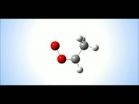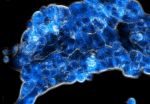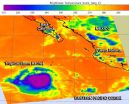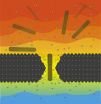(Press-News.org) VIDEO:
Earth's atmosphere is a complicated dance of molecules. The chemical output of plants, animals and human industry rise into the air and pair off in sequences of chemical reactions. Such...
Click here for more information.
Earth's atmosphere is a complicated dance of molecules. The chemical output of plants, animals and human industry rise into the air and pair off in sequences of chemical reactions. Such processes help maintain the atmosphere's chemical balance; for example, some break down pollutants emitted from the burning of fossil fuels.
Understanding exactly how these reactions proceed is critical for predicting how the atmosphere will respond to environmental changes, but some of the steps of this dance are so quick that all of the molecules involved haven't been measured in the wild.
A University of Pennsylvania team has now observed one of these rapid atmospheric reactions in the lab. They identify an important intermediate molecule and track its transformation to hydroxyl radicals, also demonstrating the amount of energy necessary for the reaction to take place.
Their findings help explain how the atmosphere maintains its reserves of hydroxyl radicals, highly reactive molecules that are called the "atmosphere's detergent."
The study was led by Marsha Lester, professor of chemistry in Penn's School of Arts & Sciences, along with members of her lab: graduate student Fang Liu and postdoctoral researcher Joseph Beames. They collaborated with Andrew Petit, also a postdoctoral researcher in the Department of Chemistry, and Anne McCoy, professor of chemistry at The Ohio State University.
Their work was published in Science.
Hydroxyl radicals are composed of a hydrogen atom bonded to an oxygen atom. They are highly reactive, readily stealing hydrogen atoms from other molecules to form water. Many common pollutants and greenhouse gases, such as methane and more complex hydrocarbons, are initially broken down by these radicals.
"Hydroxyl radicals are called the atmosphere's detergent because most pollutants that go into the air are broken down by them," Lester said. "Since they're so reactive, the question is then. 'How is it that there is so much of it in the atmosphere?' They're reacting away all of the time, so they must be constantly replenished."
The sun is responsible for most of the hydroxyl radicals in the air in the daytime. Sunlight has sufficient energy to breakdown ozone, releasing oxygen atoms that react with water vapor to produce hydroxyl radicals. However, another important source of these molecules does not require sunlight. This less-well-understood process, investigated by the Lester team, is the dominant source of hydroxyl radicals at night, and plays a large role in the atmosphere during the winter.
In 1949, German chemist Rudolf Criegee hypothesized that alkenes, a class of chemicals with carbon double bonds, were broken down in reaction with ozone by way of intermediate molecules that were even more reactive and short-lived, so much so that they eluded detection until very recently. These intermediate molecules are now known as "Criegee intermediates."
Lester's team is now the first to track a Criegee intermediate through the reaction that results in a hydroxyl radical, using a technique known as infrared action spectroscopy.
"We used a laser to generate a 'fingerprint' of this intermediate molecule, based on the wavelengths of light it absorbs," Lester said. "The laser also supplies the energy necessary to drive the reaction, which would be provided by heat under atmospheric conditions."
"At the end," said Beames, "we also detected the hydroxyl radicals, so we're the first to actually show that the hydroxyl radicals are produced directly from the Criegee intermediate."
"We see that a hydrogen atom from one end of the intermediate molecule transfers over and bonds to an oxygen atom on the other side," said Liu. "The molecule then breaks apart, resulting in a hydroxyl radical."
The team believes that the new understanding of the amount of energy necessary to drive this hydrogen transfer reaction will have implications for many of the hydroxyl-radical-producing reactions that involve Criegee intermediates.
"If you're going over a mountain — the energy it takes to drive the reaction — there are certain pathways it makes sense to follow," Petit said. "We're studying the simplest of this class of molecules so we think this pathway will be relevant to the others in the series."
A more complete picture of how the hydroxyl radicals are produced on an hour-to-hour and season-to-season basis will be instrumental to developing more accurate models of the atmosphere. Hydroxyl radical production through this route can also vary geographically, as the precursors to the reaction — alkenes — are more readily found above urban and forested regions.
"You can't measure everything," Lester said, "so we need good models to predict how the atmosphere will respond to changes in the environment, whether those changes are temperature, ozone levels or the presence of petrochemicals."
INFORMATION:
The research was supported by the National Science Foundation, Dreyfus Postdoctoral Program in Environmental Chemistry, American Chemical Society Petroleum Research Fund and Air Force Office of Scientific Research.
Penn chemists observe key reaction for producing 'atmosphere's detergent'
2014-09-26
ELSE PRESS RELEASES FROM THIS DATE:
National Geographic/GlobeScan study reveals increased concern about environment
2014-09-26
WASHINGTON (Sept. 26, 2014)—A new global analysis released today by the National Geographic Society and GlobeScan finds that concern about environmental problems has increased in most countries surveyed, and that more people now expect global warming will negatively affect them during their lifetime than in 2012. Despite this, National Geographic's Greendex, a comprehensive measure of consumer behavior in 65 areas related to housing, transportation, food and consumer goods, shows that sustainable consumer behavior has only grown slowly.
Results of the 2014 Greendex, a ...
Strategy to reduce side effects in modern cancer therapy
2014-09-26
This news release is available in German. An interdisciplinary team of researchers from the University of Vienna (Institute of Inorganic Chemistry) and the Medical University of Vienna (Institute for Cancer Research) has successfully developed a new strategy for reducing the often serious side effects of an important class of modern anticancer drugs (tyrosine kinase inhibitors). The novel drug is supposed to restrict its activity with high selectivity to the malignant tumour.
The occurrence of severe side effects and the development of resistance are two of the biggest ...
Sensitive youngsters
2014-09-26
Young individuals of a species are often more sensitive towards environmental stress than their adult counterparts. Scientists from GEOMAR Helmholtz Centre for Ocean Research Kiel now observed this effect in the sea star Asterias rubens from the Baltic Sea. In a long-term laboratory experiment that was conducted in the framework of the German research network BIOACID (Biological Impacts of Ocean Acidification), the researchers simulated three different levels of acidification that could be reached in the Baltic Sea by the uptake of additional carbon dioxide (CO2) within ...
Study identifies unexpected clue to peripheral neuropathies
2014-09-26
CINCINNATI – New research shows that disrupting the molecular function of a tumor suppressor causes improper formation of a protective insulating sheath on peripheral nerves – leading to neuropathy and muscle wasting in mice similar to that in human diabetes and neurodegeneration.
Scientists from Cincinnati Children's Hospital Medical Center report their findings online Sept. 26 in Nature Communications. The study suggests that normal molecular function of the tumor suppressor gene Lkb1 is essential to an important metabolic transition in cells as peripheral nerves (called ...
NASA identifies cold cloud tops in Tropical Storm Rachel
2014-09-26
NASA's Aqua satellite saw the area of strong thunderstorms with colder cloud tops had grown within the Eastern Pacific Ocean's Tropical Storm Rachel.
NASA's Aqua satellite passed over the large Tropical Storm Rachel on Sept. 25 at 4:41 p.m. EDT and the Atmospheric Infrared Sounder or AIRS instrument, saw that the extent of colder cloud tops had increased, indicating thunderstorm heights were increasing and it was strengthening. The expansion of those stronger thunderstorms also suggests that the northeasterly wind shear may be relaxing a little. The strongest thunderstorms ...
Underwater robot for port security
2014-09-26
Last week, at the International Conference on Intelligent Robots and Systems, MIT researchers unveiled an oval-shaped submersible robot, a little smaller than a football, with a flattened panel on one side that it can slide along an underwater surface to perform ultrasound scans.
Originally designed to look for cracks in nuclear reactors' water tanks, the robot could also inspect ships for the false hulls and propeller shafts that smugglers frequently use to hide contraband. Because of its small size and unique propulsion mechanism — which leaves no visible wake — the ...
Penn team studies nanocrystals by passing them through tiny pores
2014-09-26
An interdisciplinary team of University of Pennsylvania researchers has now applied a cutting-edge technique for rapid gene sequencing toward measuring other nanoscopic structures. By passing nanoscale spheres and rods through a tiny hole in a membrane, the team was able to measure the electrical properties of those structures' surfaces.
Their findings suggest new ways of using this technique, known as "nanopore translocation," to analyze objects at the smallest scale.
The research was led by Marija Drndić, professor in the Department of Physics and Astronomy ...
Geisel researchers contribute to study of trained immunity
2014-09-26
Hanover, NH - A study published in the journal Science provides support for a new—and still controversial—understanding of the immune system. The research was conducted by collaborators in the U.S. and Europe, including Robert Cramer, PhD, an assistant professor of microbiology and immunology at the Geisel School of Medicine and member of the Dartmouth Lung Biology Center, and Kelly Shepherdson, PhD, at the time a graduate student in Cramer's lab.
Typically, scientists divide the immune system into two categories: the innate immune response and the adaptive immune response. ...
New UT Dallas technology may lead to prolonged power in mobile devices
2014-09-26
Researchers from The University of Texas at Dallas have created technology that could be the first step toward wearable computers with self-contained power sources or, more immediately, a smartphone that doesn't die after a few hours of heavy use.
This technology, published online in Nature Communications, taps into the power of a single electron to control energy consumption inside transistors, which are at the core of most modern electronic systems.
Researchers from the Erik Jonsson School of Engineering and Computer Science found that by adding a specific atomic ...
High-throughput cell-sorting method can separate 10 billion bacterial cells in 30 minutes
2014-09-26
University of Hawaii at Manoa College of Engineering mechanical engineer Yi Zuo has developed a new, high-throughput method for sorting cells capable of separating 10 billion bacterial cells in 30 minutes.
The finding has already proven useful for studying bacterial cells and microalgae, and could one day have direct applications for biomedical research and environmental science—basically any field in which a large quantity of microbial samples need to be processed.
The new method was described in a September 2014 publication in the scientific journal Analytical Chemistry, ...






